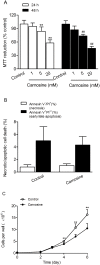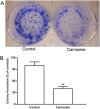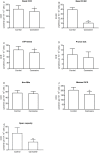Carnosine inhibits the proliferation of human gastric cancer SGC-7901 cells through both of the mitochondrial respiration and glycolysis pathways
- PMID: 25115854
- PMCID: PMC4130552
- DOI: 10.1371/journal.pone.0104632
Carnosine inhibits the proliferation of human gastric cancer SGC-7901 cells through both of the mitochondrial respiration and glycolysis pathways
Abstract
Carnosine, a naturally occurring dipeptide, has been recently demonstrated to possess anti-tumor activity. However, its underlying mechanism is unclear. In this study, we investigated the effect and mechanism of carnosine on the cell viability and proliferation of the cultured human gastric cancer SGC-7901 cells. Carnosine treatment did not induce cell apoptosis or necrosis, but reduced the proliferative capacity of SGC-7901 cells. Seahorse analysis showed SGC-7901 cells cultured with pyruvate have active mitochondria, and depend on mitochondrial oxidative phosphorylation more than glycolysis pathway for generation of ATP. Carnosine markedly decreased the absolute value of mitochondrial ATP-linked respiration, and reduced the maximal oxygen consumption and spare respiratory capacity, which may reduce mitochondrial function correlated with proliferative potential. Simultaneously, carnosine also reduced the extracellular acidification rate and glycolysis of SGC-7901 cells. Our results suggested that carnosine is a potential regulator of energy metabolism of SGC-7901 cells both in the anaerobic and aerobic pathways, and provided a clue for preclinical and clinical evaluation of carnosine for gastric cancer therapy.
Conflict of interest statement
Figures








Similar articles
-
Profiling and targeting of cellular mitochondrial bioenergetics: inhibition of human gastric cancer cell growth by carnosine.Acta Pharmacol Sin. 2019 Jul;40(7):938-948. doi: 10.1038/s41401-018-0182-8. Epub 2018 Dec 18. Acta Pharmacol Sin. 2019. PMID: 30560903 Free PMC article.
-
Carnosine Inhibits the Proliferation of Human Cervical Gland Carcinoma Cells Through Inhibiting Both Mitochondrial Bioenergetics and Glycolysis Pathways and Retarding Cell Cycle Progression.Integr Cancer Ther. 2018 Mar;17(1):80-91. doi: 10.1177/1534735416684551. Epub 2016 Dec 23. Integr Cancer Ther. 2018. PMID: 28008780 Free PMC article.
-
Carnosine inhibits ATP production in cells from malignant glioma.Neurol Res. 2010 Feb;32(1):101-5. doi: 10.1179/016164109X12518779082237. Epub 2009 Nov 11. Neurol Res. 2010. PMID: 19909581
-
Alterations in bioenergetics due to changes in mitochondrial DNA copy number.Methods. 2010 Aug;51(4):452-7. doi: 10.1016/j.ymeth.2010.03.006. Epub 2010 Mar 25. Methods. 2010. PMID: 20347038 Review.
-
Aerobic glycolysis: meeting the metabolic requirements of cell proliferation.Annu Rev Cell Dev Biol. 2011;27:441-64. doi: 10.1146/annurev-cellbio-092910-154237. Annu Rev Cell Dev Biol. 2011. PMID: 21985671 Review.
Cited by
-
L-carnosine enhanced reproductive potential of the Saccharomyces cerevisiae yeast growing on medium containing glucose as a source of carbon.Biogerontology. 2016 Aug;17(4):737-47. doi: 10.1007/s10522-016-9645-9. Epub 2016 Apr 4. Biogerontology. 2016. PMID: 27040824 Free PMC article.
-
Carnosine selectively inhibits migration of IDH-wildtype glioblastoma cells in a co-culture model with fibroblasts.Cancer Cell Int. 2018 Aug 13;18:111. doi: 10.1186/s12935-018-0611-2. eCollection 2018. Cancer Cell Int. 2018. PMID: 30123089 Free PMC article.
-
Methylglyoxal, a glycolysis side-product, induces Hsp90 glycation and YAP-mediated tumor growth and metastasis.Elife. 2016 Oct 19;5:e19375. doi: 10.7554/eLife.19375. Elife. 2016. PMID: 27759563 Free PMC article.
-
Radio-selective effects of a natural occurring muscle-derived dipeptide in A549 and normal cell lines.Sci Rep. 2019 Aug 8;9(1):11513. doi: 10.1038/s41598-019-47944-5. Sci Rep. 2019. PMID: 31395939 Free PMC article.
-
Characterisation of intracellular molecular mechanisms modulated by carnosine in porcine myoblasts under basal and oxidative stress conditions.PLoS One. 2020 Sep 18;15(9):e0239496. doi: 10.1371/journal.pone.0239496. eCollection 2020. PLoS One. 2020. PMID: 32946513 Free PMC article.
References
-
- Bonfanti L, Peretto P, De Marchis S, Fasolo A (1999) Carnosine-related dipeptides in the mammalian brain. Prog Neurobiol 59: 333–353. - PubMed
-
- De Marchis S, Modena C, Peretto P, Migheli A, Margolis FL, et al. (2000) Carnosine-related dipeptides in neurons and glia. Biochemistry (Mosc) 65: 824–833. - PubMed
Publication types
MeSH terms
Substances
LinkOut - more resources
Full Text Sources
Other Literature Sources
Medical

